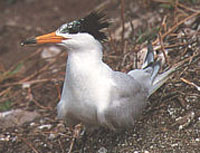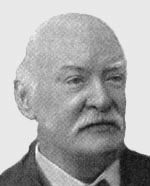Sinological Profiles
Gustaaf Schlegel
1840 - 1903Schlegel's naturalist father Hermann (1804-1884), a native of Saxony who had been trained in Vienna, had moved to the Netherlands in 1827 to join the staff of the Leiden Museum. He had a definite interest in things Oriental. He was prevented by circumstances from joining the Natural History Commission in the Dutch Indies, but collaborated with his friend Philipp Franz von Siebold in the major survey Fauna Japonica (1845-1850). Hermann's son Gustaaf, who had begun studying Chinese at the age of 9 with the Leiden Japanologist J J Hoffmann, sailed for China in October 1857 to collect specimens for his father, spending a few months in Macao and then shifting to Amoy, which dialect, perhaps not coincidentally, was the one of chief career interest for those entering the Dutch Colonial service, since it was spoken by most Chinese residents in the Dutch East Indies. Hermann followed up by sending Heinrich Bernstein to collect birds in New Guinea in 1859. In 1860, Hermann was named Director of the Leiden Museum, a post which he held until his death in 1884. His great work is the monumental treatise Muséum d'Histoire Naturelle des Pays-Bas, which was published in 14 volumes between 1862 and Hermann's death in 1880.
As a field naturalist, Gustaaf was eclipsed by his friend Robert Swinhoe, a member of the British consular service, who collected specimens in his spare time. Swinhoe, who returned to England in 1862, has several species named after him, including Swinhoe's Storm Petrel. But to Gustaaf's credit is the Chinese Crested Tern, which, though it is named Sterna Bernsteini for his father's other field agent, Gustaaf, in 1863, at the age of 23, was the first to describe.
After three years in Amoy, and a further year in Canton, Gustaaf in 1862 joined the Dutch colonial government in Batavia as an interpreter. His monograph on the Chinese secret society Tyen/Di Hwei or Heaven/Earth Society was published at Batavia in 1866, and was found useful by both the Dutch and British colonial administrations. Working also in an academic direction, Schlegel received his doctorate from the University of Jena in 1869, for a thesis on the customs and pastimes of the Chinese.
To provide a proper Dutch base for the initial training of future colonial officials, the Dutch government created a position in Chinese language at Leiden. The following year, Schlegel was appointed to the post, and in that same year, 1875, he published his two-volume study of Chinese astronomy. He was made a full professor in 1877. In his inaugural address, on 27 October 1877, Gustaaf stressed the importance of Chinese language study, as likely to pay off in benefits to the Chinese community in the Dutch Indies.
There presently followed an appropriately utilitarian venture: the four volumes of Schlegel's Dutch-Chinese Dictionary in the Amoy dialect, which appeared in eight parts over the period 1884-1890. On the academic side, many will consider that Schlegel's most lasting contribution is his creation in 1890, together with the Paris Sinologist Henri Cordier, of the scholarly journal T'oung Pao, linking the two leading Sinological centers of Europe. T'oung Pao has been several times discontinued and revived; it remains at the present time one of the most respected journals in the field. Also in 1890, Schlegel's student de Groot was appointed to the Chair of Ethnology, further strengthening the Leiden end of the Leiden-Paris axis. Schlegel's still cited study of parallelism in written Chinese appeared in 1896.
Not many Sinologists add to the lexicon. Schlegel is one of the few. Suitably to the terms of his Leiden appointment, and to his own practical experience, his mot bears on Chinese language learning:
Lisez! Lisez! Jetez le grammaire!
Read! Read! Throw away the grammar book!Some of us, including von der Gabelentz, whose 1881 work may have provoked Schlegel, like to use the mind to assist the baser organs of perception, but no one can deny that this brute force method worked for the pioneers. At least up to a point. The evidence should include the testimony of von Zach, who studied with Schlegel and de Groot at Leiden from 1896, and in 1897 did a joint article for T'oung Pao with Schlegel, himself doing the Manchu parts of a parallel text and Schlegel the Chinese parts. In Schlegel's half, von Zach was later to say, "not a single sentence was translated correctly." von Zach on one occasion referred to Schlegel as a "pathological phenomenon." This is perhaps a little strong, and on the question of whether the mind has a use in Sinology, we consider that the jury is still out.
On 27 Oct 1902, in a ceremony which received international attention, Schlegel celebrated the silver anniversary of his Leiden Professorship, a year longer than his father's tenure at the Leiden Museum. In that year, his Siamese Studies appeared as a supplement to volume 2 of the revived T'oung Pao. On a less festive note, there also appeared, halfway around the world in Peking, von Zach's criticism of Schlegel's 1893 piece on Chinese parallelism. Schlegel died the the following year, and was succeeded by de Groot, who shifted from the Chair of Ethnology. The Chair of Chinese fell vacant after de Groot moved to Berlin in 1912, and was revived only in 1919 with the appointment of Duyvendak. The interval marks the divide between the old era, when Dutch Sinology was closely linked to the needs of the Dutch colonial service, and the new.
E Bruce Brooks
References
- Gustave Schlegel. Thian Ti Hwui: The Hung-League, or Heaven-Earth-League, a Secret Society with the Chinese in China and India. [Batavia] Lange 1866
- Gustave Schlegel. Uranographie Chinoise. 2v Brill 1875
- Gustaaf Schlegel. Nederlandsch-Chineesch Woordenboek met de Transcriptie der Chineesche Karakters in het Tsiang-Tsiu Dialekt. Hoofdzakelijk ten Behoeve der Tolken voor de Chineesche Taal in Nederlandsch-Indië. 4v in 8, Brill 1884-1890
- Gustave Schlegel. La Prostitution en Chine. [Rouen] 1886. A pamphlet of 46 pages
- Gustaaf Schlegel. Desultory Notes on Japanese Lexicography. Brill 1893. A pamphlet of 45 pages
- Alphabetical List of the Emperors of China and Japan. Brill 1893. A pamphlet of 70 pages. The second part, listing "the Shoguns and Mikados of Japan," was written by Schlegel
- Gustaaf Schlegel. La Loi du Parallélisme en Style Chinois Démontrée par la Préface du Si-Yü Ki. Brill 1896
- Erwin von Zach. Einige Worte zu Prof. Gustav Schlegel's 'La Loi du Parallélisme en Style Chinois.' [Peking] 1902
This profile is indebted to an outline history of Dutch Sinology by Wilt Idema, and to a similar outline at Leiden University; differences between the two have been resolved in favor of the latter.
9 June 2004 / Contact The Project / Exit to Sinology Page

